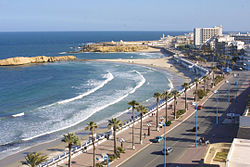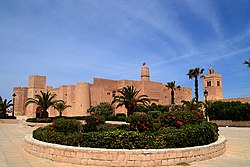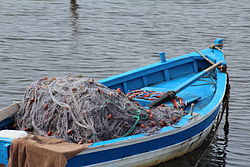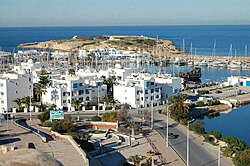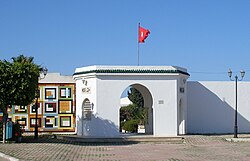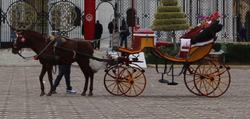WikiArabia2015/Travel
Monastir
[edit]Welcome to Monastir where you will have your fill of blue sky and sunshine, where you will find extraordinary heritage and original traditions, where you will enjoy twinkling sea. Monastir is a tourist city on the eastern coast of Tunisia. It has many fine hotels and restaurants. It has also many faculties part of the University of Monastir.
"Modern Monastir extends beyond the old town and along the coast. It is full of hotels and tourist amenities, making it a modern seaside resort."
"Coloured boats on a beach of very fine sand, and then the sea, its colour growing gradually darker, from the almost white azure at the water's edge to dark blue towards the horizon. The image of relaxing, holidays and carefree existence is just one the many that Monastir has in store for the tourist."
In 2004, the population of the municipality is 71,546 inhabitants.
-
Al Qurayyah beach in Monastir
-
Beach in Monastir
-
Sea view at Monastir
Climate
[edit]Monastir enjoys a dry Mediterranean climate with hot summers, extremely mild winters, lots of sunshine and low rainfall year round. The city sits in the northeast of Tunisia, on its central coast. It is much hotter than the Mediterranean resorts on the European coast, but much milder than inland areas of Tunisia, forty percent of which is part of the Sahara. Summer, from June till September, is absolutely sweltering. If you spend too long outside, you’ll find yourself melted to the spot or wilting in the shade. While humidity is low, the soaring heat can still be hard to handle. The average high temperature of 29°C in June skips past the 30°C mark in the middle of the month and climbs up to 33°C in July and August.
Language
[edit]Tunisians are willing to learn foreign languages. Tourists usually don't find problems communicating with Tunisians. Arabic is the native language. French is spoken fluently by almost every Tunisian and is often used in many fields (press, radios and all road signs). English is the third spoken language in Tunisia and it's well spoken, especially in touristic areas.
Cuisine
[edit]Appreciated by tasters, Tunisian cuisine owes its variety to the richness of its soil and the contributions of different traditions: Berber, Arab, Turkish and even Italian... Tunisian people love a good taste and give much attention to what they eat. Welcome to a tasty world full of colors and savory surprises! A sunny cuisine where lamb mixes with sea bream and grouper, where almonds blend with peppers and rosebuds, and where olive oil is combined with carefully selected spices. The celebrated couscous can be cooked in countless different ways: with fish, dried meat, meatballs, stuffed squid... A crispy hors-d'oeuvre and delicious almond patisseries are made from filo pastry, bequeathed by Turks. The meal is accompanied with the traditional mint tea accompanied by sweets. Restaurants are classed as "touristic restaurants" with a rating of 1 to 3 forks.
The following table lists the touristic restaurants in Monastir:
| Name | Category | Address | Phone |
|---|---|---|---|
| Le Grill | 3F | Marina Cap Monastir | (+216) 73 462 136 |
| The Captain | 3F | Marina Cap Monastir | (+216) 73 461 449 |
| Le Chandelier | 2F | Marina Cap Monastir | (+216) 73 462 232 |
| Le Central | 2F | Marina Cap Monastir | (+216) 73 461 597 |
| Le Pêcheur | 2F | Marina Cap Monastir | (+216) 73 468 136 |
| The Kings | 2F | Complex Ribat | (+216) 73 463 394 |
| Horizon Bleu | 2F | Complex Ribat | (+216) 73 463 150 |
| Skanes Palm | 2F | Dkhila Monastir | (+216) 73 521 159 |
| Al Felha | 2F | Sahline | (+216) 73 513 769 |
| Salsa Posada | 1F | Dkhila Monastir | (+216) 73 524 051 |
| Le Farik | 1F | Route de la Corniche | (+216) 73 460 517 |
| Calypso | 1F | Marina Cap Monastir | (+216) 73 462 305 |
| La Plage | 1F | Place du 3-Août | (+216) 73 461 124 |
Sights
[edit]Ribat
[edit]Monastir's star attraction is its preserved ribat complex, considered as the country's finest example of Islamic military architecture. Its seemingly chaotic design with labyrinthine passageways and staircases is a legacy of the ribat's many periods of construction and renovation. The consequence is an evocative structure devoid of any uniformity. The original ribat occupied only the central courtyard and museum area and was built in AD 796. The current shape was established by the Aghlabids at the end of the 9th century and completed during the 11th century. The ribat of Monastir is erected by the wali Harthama Ben Ayan on an order of the Abbasid caliph Harun al-Rashid in 796, to serve as a defense against attacks of the Byzantine fleet on the Mediterranean Sea. It represents, with the ribat of Sousse, one of the two most important of the Sahel coast fortresses. There are panoramic views of the town and the coast line from the ramparts.
"One of the monuments that is symbol of the town, the spectacular ribat, facing the sea and strongly fortified, with battlements, turrets and a central tower from the top of which you can enjoy a wide, enchanting view of the sea, the medina, the mosques and the mausoleum of Habib Bourguiba. Because of its great beauty, the Monastir ribat has been chosen as the set for many film productions, including Franco Zeffirelli's Jesus of Nazareth. Its construction goes back to 796, which is why it's considered to be the oldest Arab fortification in Tunisia."
-
A slot in the tower of the ribat of Monastir
-
View of the ribat of Monastir
-
Courtyard of the ribat of Monastir
Medina
[edit]Monastir's medina was largely demolished after independence in an ill-considered rush to modernise the town and keeping with its status as the birthplace of the president. Thankfully, the ribat survived, as did the Great Mosque. Built in the 9th century, it's a severe Aghlabid creation, apart from the graceful horseshoe arches at the northern end. Roman columns supporting these arches and thoe of the prayer hall (closed to non-Muslims) were salvaged from the ruins of ancient Ruspina. The walls in the western part of the medina remain largely intact and are the dotted with some interesting old gates, the finest one is Bab el-Gharbi, at the centre of the western wall. It was built by the Hafsids during the 15th century. Bab Tunis, at the northwestern corner, was built in 1780 while the main southern gate, Bab Briqcha, was built by the Ottomans at the end of the 17th century.
The Costumes Museum is around the corner from the tourist office and worth a quick look.
Mausoleum of Habib Bourguiba
[edit]The visitors to Monastir should not leave without visiting the mausoleum of Habib Bourguiba and his family. The mausoleum could be reached via a paved walkway, the gold and green cupolas are very attractive for new comers. The marble courtyard, green-tiled arches and elegant eastern doors are superb.
The mausoleum houses tombs of the family and a small display of items that belonged to the first president of Tunisia. The admission is free of charge and it is open Mondays to Saturdays. If the main gate is occasionally closed, visitors can walk around the fence to the next small gate on the northern side.
"Monastir's other, spectacular symbol is the Mausoleum of Habib Bourguiba, statesman and father of Tunisian independence, who was born in this town on 3 August 1902 and has been buried here since April 2000. The great monument is laid out as a central building covered with a large gilt dome, containing Bourguiba's tomb, surrounded by three other green domes, where the president's father, mother and first wife are buried. At the sides, there are 25-meter high minarets topped with gilt spires and the whole structure is covered in precious marble."
The Old Port
[edit]The old symbolic port has an excellent location and panoramic views.
-
Fishing boats and sailors
-
Nice old boat
-
Panoramic view
Marina
[edit]The marina and its modern installations offer to the admiring looks its enormous yachts, floating and slender luxury hotels. Small modern bearing settled below the ledge, northeast from the city center, differs not at all from a Mediterranean resort: cafés, restaurants, ice-cream makers, bar serving cocktails, shops, etc. The site also includes a hammam on the west. Of the pier, we can see the Pigeons island and guess the marine caves of El Khalif.
-
Monastir Marina
-
Monastir Marina
-
Boat at Monastir Marina
-
Overview of Monastir Marina
Museums
[edit]- Museum of popular arts and traditions of Monastir: This museum displays traditional Tunisian costumes, most of which are wedding costumes, adornments, woven domestic items and copper objects.
- Islamic Arts Museum of Monastir: It contains a collection of early Arab coins, pottery, old maps and photos of Monastir.
- Leader Habib Bourguiba Museum: This museum is created after the 2011 revolution. It displays more than 1,360 objects, personal properties found in the presidential palace of Carthage, photo albums, sound recordings, archives, Rolls-Royce, bronze equestrian statue and gifts, all of the former president Habib Bourguiba.
- Moknine Museum: It is both an archeological and an ethnographical museum reflecting the past and the present of the town of Moknine and its region that for thousands of years have been rooted in the rich history of Tunisia. It displays ceramics, collection of bronze objects dating back to the 5th century, jewelry, costumes and distinctive features of this town.
- Lamta Archaeological Museum: The museum traces the origins of ancient Leptiminus, founded by sailors who came from Phoenicia around the 12th century BC. It presents all aspects of life: economic, social, cultural and religious, as well as different techniques at use during that period. The museum’s garden contains many vestiges, including in particular remains of imposing baths.
-
Museum of popular arts and traditions of Monastir
-
Facade of the Leader Habib Bourguiba Museum
-
Gate of the Lamta Archaeological Museum
Activities
[edit]- Touristic bicycle
You can discover the town (ribat, medina, marina, etc.) with family and friends, without producing CO2 and for health benefits. Whether it's to boost your fitness, health or bank balance, taking up cycling could be one of the best decisions you ever make, and everyone can develop circuits map at their own pace according to their tastes and abilities.
- Carriage
You can also go around Monastir with the famous and traditional carriages and of course for a good price.
- Touristic train
It is a cheap and original mean to discover the city. During the conference, the touristic train will be used to move between the Monastir Sciences Palace and the faculties of dental medicine and pharmacy, where workshops will be held.
- Karting
The Palm Karting Monastir offers a great deal for those who are passionate of karting or those who want to try it. With its two circuits (adults and kids), we can organize karting group competitions for great prices. It also has a coffee shop, a great Mexican restaurant and a nice party space.
-
Carriage in Monastir
-
Karting Monastir
-
Touristic train in Monastir
Safety
[edit]Safety and security measures are paramount in events organized in Tunisia. Thus, fire extinguishers and first aid kits are required in public places. International events held in Tunisia are assisted with police presence as well as an ambulance in case of emergencies.
In addition, Tunisians are known for their hospitality and good sense of humour which makes Tunisia one of the best Mediterranean travel destinations.

